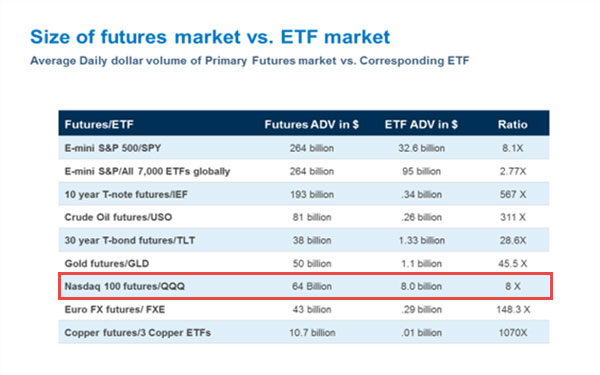FACTOID: Year-to-Date June 12, 2018, E-mini Nasdaq-100 futures out-trade the FANGs stocks (Facebook, Amazon, Netflix, Google) in average daily notional amount by a factor of three.
In 1999, stocks were riding a 17-year bull market. And outperforming all other sectors were technology stocks, as they were in a massive rise that dwarfed the major averages. During this time, two products were launched that would change the face of investing in technology.
In March, the Nasdaq-100 ETF (ticker: QQQ) launched and became quite successful. A few months later, CME Group introduced an E-mini futures contract on the Nasdaq-100 Index. It too, became a hit relatively quickly.
Investors would be able to invest in a basket of the top members of the technology sector with the click of a mouse. Moreover, both products had extremely high correlations since both tracked the Nasdaq-100 cash Index. This high correlation allows for hedging and spreading opportunities for investors.
And with the convergence of the internet, online trading and a major bull market in tech shares (not to mention the huge success of the E-mini S&P 500), both products met with tremendous success. But over the last 19 years since the launch of these two products, the dollar flows into the E-mini Nasdaq 100 futures (ticker: NQ) pulled away from the Nasdaq-100 ETF (QQQ) and now are far greater.
When you compare futures, like NQ, with QQQ ETF, it should come as no surprise why futures far out-trade ETFs. Let’s do a detailed comparison of the futures with ETFs and see why futures are the more compelling instrument.
| Benefit | Nasdaq-100 Futures (NQ) | Nasdaq-100 ETF (QQQ) |
|---|---|---|
| Management fees | None, there are no annual management fees with NQ | QQQ has .20% annual management fee |
| Capital efficiencies | Futures margin is capital efficient, with performance bond margins usually less than 5% of notional amount ($5,800 currently) | Reg-T margins with stocks and ETFs are 50% of the value of the stock or ETF, far larger than futures |
| 24-hour trading access | Yes—trades nearly 24-hours daily; beginning Sunday evening through Friday afternoon | While some firms offer after hours trading, ETFs cannot be traded 24 hours a day |
| Liquidity | Primary futures contracts such as E-mini, Treasuries, Crude, and Metals, all far out-trade (in dollar terms) their ETF counterpart (see chart below) | Good liquidity but not as much critical mass as futures (see chart below) |
| Tracking to underlying | Futures track underlying index very closely, minimizing tracking error | Some ETFs have major tracking error, though QQQ tracks closely |
| Tax advantages | Profitable short-term trades with futures will pay significantly less in taxes than with an ETF due to IRS Section 1256 treatment (60/40 blend of short- and long-term gains) | All short-term profits with ETFs pay ordinary income rates. |
Clearly, futures offer some compelling advantages to large and small investors alike. These advantages have not gone unnoticed by equity and technology investors. In fact, if you look at the average daily dollar volume comparisons between Nasdaq futures and their corresponding ETF (see Figure 2, highlighted in red), you will notice that futures trade eight times the average daily dollar amount of their ETF counterpart.
In addition, futures on Treasuries, Crude Oil and Gold trade far greater notional amounts per day than their corresponding ETFs each day.
FIGURE 2:

SOURCE: CME GROUP, BLOOMBERG
While it is true that both futures and ETFs are regarded as two of the most successful instruments ever introduced, futures hold the lead in many categories in a head-to-head comparison.
Test your knowledge
ACCREDITED COURSE
Did you know that CME Institute classes can fulfill CFA and GARP continuing education requirements? Every CME Institute course can be self-reported in your CFA online CE tracker and select classes can be used for GARP credits. See which of our classes qualify for GARP credits here.
What did you think of this course?
To help us improve our education materials, please provide your feedback.